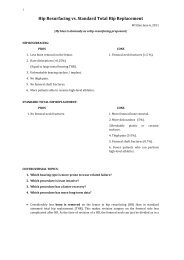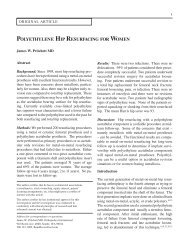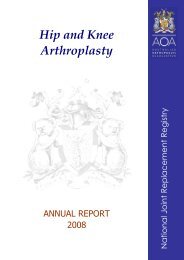Birmingham H ip Resurfacing v ersus C onserv e Plus M etal-on-M ...
Birmingham H ip Resurfacing v ersus C onserv e Plus M etal-on-M ...
Birmingham H ip Resurfacing v ersus C onserv e Plus M etal-on-M ...
You also want an ePaper? Increase the reach of your titles
YUMPU automatically turns print PDFs into web optimized ePapers that Google loves.
M<str<strong>on</strong>g>etal</str<strong>on</strong>g> I<strong>on</strong> Measurements<br />
I have been collecting blood from c<strong>on</strong>senting patients prior to revisi<strong>on</strong> surgeries (and at routine follow-up), as well as h<str<strong>on</strong>g>ip</str<strong>on</strong>g> fluid taken from<br />
the joint at the time of revisi<strong>on</strong> surgery. The levels of m<str<strong>on</strong>g>etal</str<strong>on</strong>g> i<strong>on</strong>s have been measured with inductively-coupled plasma mass spectrophotometry with a<br />
resoluti<strong>on</strong> of 0.5ppb. Looking at the wear and i<strong>on</strong> data together, it can be shown that chromium and cobalt levels are correlated with the wear of the<br />
prosthesis. [De Smet, 2008] (Fig 5)<br />
Copyright Dr. Koen De Smet<br />
Fig 5. Correlati<strong>on</strong> between femoral comp<strong>on</strong>ent wear depth and serum i<strong>on</strong> levels.<br />
In the data from the Amstutz C<str<strong>on</strong>g><strong>on</strong>serv</str<strong>on</strong>g>e <str<strong>on</strong>g>Plus</str<strong>on</strong>g> series, and the published study of BHR i<strong>on</strong> values by Back et al, [Back, 2005] the m<str<strong>on</strong>g>etal</str<strong>on</strong>g> i<strong>on</strong><br />
levels are measured prospectively and l<strong>on</strong>gitudinally in a relatively large cohort of h<str<strong>on</strong>g>ip</str<strong>on</strong>g> resurfacing patients where the same surge<strong>on</strong> did the implanti<strong>on</strong>s,<br />
and the same lab did the m<str<strong>on</strong>g>etal</str<strong>on</strong>g> i<strong>on</strong> testing. My patient i<strong>on</strong> data is shown against those data (Fig 6) (ANCA series) and this proof is even more evident.<br />
These m<str<strong>on</strong>g>etal</str<strong>on</strong>g> i<strong>on</strong> levels are from normal, well-functi<strong>on</strong>ing resurfacing prostheses where the chromium serum level was not higher than 5 μg/l or 5 ppb.<br />
Therefore the claim that implants which have been heat treated after casting will have higher wear, (and therefore higher i<strong>on</strong>s) is not supported by this<br />
data.<br />
Fig 6. M<str<strong>on</strong>g>etal</str<strong>on</strong>g> i<strong>on</strong> levels from the patients in my series compared with those reported with the BHR by Back et. al. and with the<br />
CONSERVE <str<strong>on</strong>g>Plus</str<strong>on</strong>g> reported by Sk<str<strong>on</strong>g>ip</str<strong>on</strong>g>or, et. al. All values are reported for blood serum, however it must be noted that the measurements<br />
were c<strong>on</strong>ducted at different instituti<strong>on</strong>s. [Sk<str<strong>on</strong>g>ip</str<strong>on</strong>g>or, 2002]<br />
6<br />
Sample Interval BHR C<str<strong>on</strong>g><strong>on</strong>serv</str<strong>on</strong>g>e <str<strong>on</strong>g>Plus</str<strong>on</strong>g><br />
1 year 2,9 μg/l chromium 1,6<br />
2 year 2,9 1,8<br />
3 year 2,4 2,1<br />
Total Average of CrS 2,4 1,8<br />
Total Count of ID 236 104<br />
Table 3. Results of chromium i<strong>on</strong> measurements of ANCA h<str<strong>on</strong>g>ip</str<strong>on</strong>g> resurfacing patients






